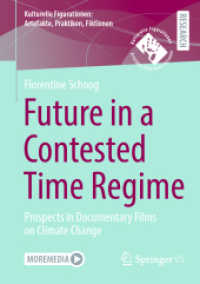Full Description
Winner of the 2019 Mark E. Mack Community Engagement Award from the Society for Historical Archaeology, the collaborative archaeology project at the former Stewart Indian School documents the archaeology and history of a heritage project at a boarding school for American Indian children in the Western United States. In Collaborative Archaeology at Stewart Indian School, the team's collective efforts shed light on the children's education, foodways, entertainment, health, and resilience in the face of the US government's attempt to forcibly assimilate Native populations at the turn of the twentieth century, as well as school life in later years after reforms.
This edited volume addresses the theory, methods, and outcomes of collaborative archaeology conducted at the Stewart Indian School site and is a genuine collective effort between archaeologists, tribal members, and former students of the school including University of Nevada, Reno, Nevada Indian Commission, and Washoe Tribal Historic Preservation Office. With more than twenty contributing authors, over half of which are tribal members (Washoe, Paiute, and Shoshone), this rich case study is strongly influenced by previous work in collaborative and Indigenous archaeologies. It elaborates on these efforts by applying concepts of governmentality (legal instruments and practices that constrain and enable decisions, in this case, regarding the management of historical populations and modern heritage resources) as well as social capital (valued relations with others, in this case, between Native and non-Native stakeholders).
As told through the trials, errors, shared experiences, sobering memories, and stunning accomplishments of a group of students, archaeologists, and tribal members, this rare gem humanizes archaeological method and theory and bolsters collaborative archaeological research.
Contents
Foreword: Digging into Indian Education, Joe Watkins
A Multivocal Collaboration Story, Sarah E. Cowie, Diane L. Teeman, Christopher C. LeBlanc, Terri McBride, and Ashley M. Long
Theoretical Approaches to Collaborative Archaeology, Diane L. Teeman, Sarah E. Cowie, Christopher C. LeBlanc and Ashley M. Long
Consensus in Research Design, and Studying Institutions, Education, and Childhood, Ashley M. Long, Sarah E. Cowie, and Christopher C. LeBlanc
Indian Education in Nevada (1890-2015): A Legacy of Change, Alex K. Ruuska
History and Daily Life at the Stewart Campus, Bonnie Thompson-Hardin
Stewart Indian School Methods and Research Results, Ashley M. Long, Sarah E. Cowie, and Ian Springer
Reflexive, Multivocal Interpretations of Stewart Indian School, and Best Practices in Heritage Management, Richard Arnold, Patrick Burtt, Sarah E. Cowie, Darrel Cruz, Eric DeSoto, Debra Harry, A. J. Johnson, Mark Johnson, Dania Jordan, Christopher C. LeBlanc, Ashley M. Long, Jo Ann Nevers, Sherry L. Rupert and Chris A. Gibbons, Diane L. Teeman, and Lonnie P. Teeman, Sr.
Concluding Lessons from Stewart Indian School: Governmentality and Social Capital in Best Practices, Diane L. Teeman, Sarah E. Cowie, Terri McBride, Ashley M. Long, and Christopher C. LeBlanc
Acknowledgments
About the Contributors






